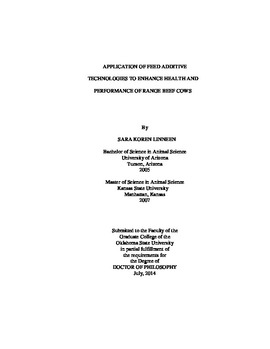| dc.contributor.advisor | Lalman, David | |
| dc.contributor.author | Linneen, Sara Koren | |
| dc.date.accessioned | 2015-06-17T20:06:46Z | |
| dc.date.available | 2015-06-17T20:06:46Z | |
| dc.date.issued | 2014-07 | |
| dc.identifier.uri | https://hdl.handle.net/11244/14972 | |
| dc.description.abstract | A total of 260 cows and 7 cannulated steers were used in four studies to the effects of Bio-Mos, monensin, and slow release urea on cow and calf performance, passive immunity, and in situ digestibility. All experiments were conducted at the Oklahoma State University North Range unit using Angus and Angus X Hereford cows and crossbred steers. All experimental diets were fed as a protein supplement containing at least 38% crude protein and: 10 g/head/d of Bio-Mos, 200 mg/head/d of monensin (cows), 250 mg/head/d monensin (steers), and 526 g of slow release urea. Feeding cows Bio-Mos in late gestation did not improve the transfer of passive immunity to the calf (P > 0.19), or calf growth performance (P > 0.43), but it improved cow BCS change for the trial duration (P = 0.05). Cows consuming monensin during late gestation and lactation did not have improved performance (P > 0.19) or milk yield (P > 0.41); however, calves born to cows consuming monensin had greater ADG from birth to the end of the feeding period (P = 0.04). Monensin also did not improve blood glucose of the cow two hours after eating (P > 0.16). When fed to steers, monensin tended to reduce DMI (P = 0.07), and increased digestibility of NDF, ADF, and DM (P < 0.01). It also significantly increased (P = 0.01) propionate at the expense of acetate and propionate indicating that steers had improved energetic efficiency from consuming monensin. Combining monensin and slow-release urea appeared to lessen the BW loss among cows consuming only slow release urea. Replacing a portion of the cottonseed meal with slow release urea did not reduce animal performance, or digestibility, making it a valid and less expensive replacement for true protein in the winter cow supplementation program. Calf growth performance is improved by feeding cows monensin, making it an effective dietary option for improving preweaning efficiency. | |
| dc.format | application/pdf | |
| dc.language | en_US | |
| dc.rights | Copyright is held by the author who has granted the Oklahoma State University Library the non-exclusive right to share this material in its institutional repository. Contact Digital Library Services at lib-dls@okstate.edu or 405-744-9161 for the permission policy on the use, reproduction or distribution of this material. | |
| dc.title | Application of feed additive technologies to enhance health and performance of forage-fed cattle | |
| dc.contributor.committeeMember | Horn, Gerald | |
| dc.contributor.committeeMember | Goad, Carla | |
| dc.contributor.committeeMember | Carter, Scott | |
| dc.contributor.committeeMember | Ritchey, Jerry | |
| osu.filename | Linneen_okstate_0664D_13436.pdf | |
| osu.accesstype | Open Access | |
| dc.type.genre | Dissertation | |
| dc.type.material | Text | |
| dc.subject.keywords | calves | |
| dc.subject.keywords | cows | |
| dc.subject.keywords | immunity | |
| dc.subject.keywords | mannan oligosaccharide | |
| thesis.degree.discipline | Animal Science | |
| thesis.degree.grantor | Oklahoma State University | |
